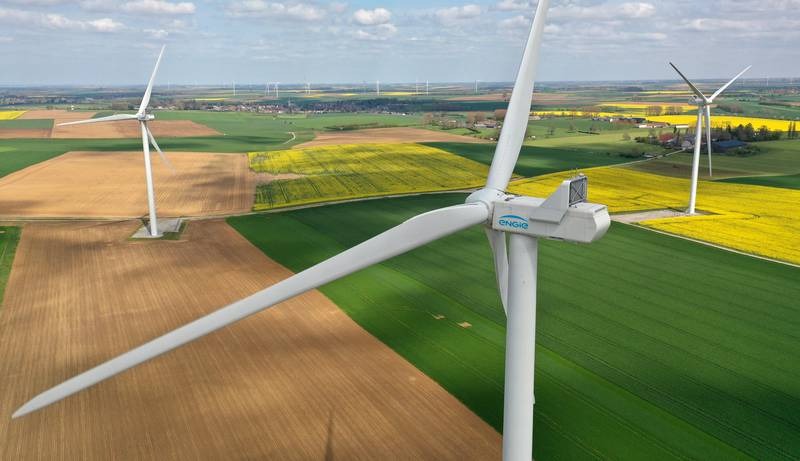Engie seeks new hydrogen projects in the UAE, Saudi Arabia and Oman
18 May, 2023

France’s Engie is keen to start new hydrogen projects in Saudi Arabia, the UAE and Oman as it aims for 4 gigawatts of green hydrogen capacity globally by 2030 amid energy transition strategies to cut emissions, a senior executive has said.
The Paris and Brussels-listed company has new projects planned in Asia, the Middle East, Africa and Europe, Stephan Gobert, Engie's senior vice president of hydrogen for Asia, Middle East and Africa, told The National in an exclusive interview.
“The Middle East region and specifically the GCC [Gulf Co-operation Council] is offering great potential … that's why we established the strategic alliance with Masdar and are studying a project at the moment in Ruwais for Fertiglobe,” he said.
“We hope to close the financial decision by the end of this year.”
Last year, Fertiglobe, the Abu Dhabi-based chemicals joint venture of energy major Adnoc and Netherlands-listed OCI, signed an agreement with Masdar as well as France’s Engie to co-develop a green hydrogen facility in the UAE for the production of ammonia. As part of the agreement, the three companies will study the development, design, financing, procurement, construction, operation and maintenance of an industrial-scale and globally cost-competitive green hydrogen facility in Al Ruwais.
It will have a potential capacity of up to 200 megawatts and be operational by 2025, with Fertiglobe as the sole long term off-taker, the companies said at the time.
In 2021, Engie and Masdar also announced a $5 billion partnership to develop the UAE’s hydrogen economy as well as develop new projects throughout the region with a capacity of at least 2 gigawatts by 2030.
“We truly believe that there is a great future for hydrogen,” Mr Gobert said.
“The demand will be very high especially in the countries where they have strong targets to decarbonise, which is the case for Japan, Korea, the European Union and the US. There is a great potential and that's why we set ourselves a target by 2030.”
Hydrogen, which can be produced using renewable energy (green hydrogen) and natural gas (blue hydrogen), is expected to play a key role in the coming years as economies and industries transition to a low-carbon world to mitigate climate change.
French investment bank Natixis estimates that investment in hydrogen will exceed $300 billion by 2030.
Ambitious net zero targets announced by countries is also boosting demand for hydrogen. The US as well as the EU aim to reach net zero by 2050.
Governments are pressuring companies and industries to decarbonise their operations and there are obligations from banks to follow ESG (environmental, social and governance) key performance indicators while lending, which will boost demand for hydrogen, Mr Gobert added.
“There are also other sectors that are transforming to reduce emissions … power generation and transport … because they are preparing for the moment which is already happening in Europe where you will have to pay for your carbon dioxide emissions. That's the carbon tax, which will have a huge impact on the balance sheet of those companies.”
A carbon tax is a type of penalty that businesses will have to pay for excessive greenhouse gas emissions. The tax is usually levied per tonne of greenhouse gas emitted.
The company also has other targets, which is to reach more than 100 refuelling hydrogen stations globally in the next seven years and to build about 700km of dedicated pipelines and storage capacity to boost hydrogen infrastructure.
Engie currently has about 30 hydrogen refuelling stations in Europe with another 20 being installed.
“There is a good chance for the Middle East countries to export towards the European Union as well as South Korea, Japan and other countries,” Mr Gobert said, adding that the EU does not have enough capacity to install new renewables to produce hydrogen because the installed renewables are already feeding the grid.
“That is where we see there is a good chance for the Middle East to export towards the European Union, because here you still have land as well as good and affordable renewables.”
The UAE as well as other countries in the region are boosting investments in renewables as countries move to lower carbon economies.
The Arab world’s second largest economy is investing Dh600 billion ($163.5 billion) in clean and renewable energy projects over the next three decades as it aims to achieve net zero emissions by 2050.
The country is building the world’s largest solar plant in the Al Dhafra region of Abu Dhabi with a capacity of 2 gigawatts, as well as the Mohammed bin Rashid Solar Park in Dubai with a 5-gigawatt capacity.
Egypt, Saudi Arabia, Morocco, Jordan and Oman are also increasing investments in clean energy projects.
The UAE aims to be among the top 10 hydrogen-producing countries globally and plans to capture 25 per cent of the low carbon hydrogen key markets amid rising demand for the fuel, Sharif Al Olama, the ministry's undersecretary for energy and petroleum affairs, told the Abu Dhabi Sustainability Week in January.
The cost of producing of hydrogen is going down with OEM manufacturers of technology like electrolysers (for producing hydrogen) reducing price amid higher demand, Mr Gobert said.
The cost of renewable energy for the production of hydrogen is also dropping, making its production cheaper, he said.
Engie is a global player in low-carbon energy and services with operations in 31 countries. The company reported a net revenue of €29.2 billion ($32 billion) in the first quarter of 2023, up 14 per cent compared with the same period last year.
Useful Links:
Source: www.thenationalnews.com
TAG(s):
